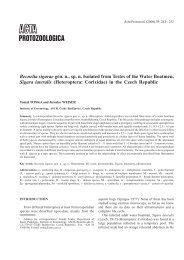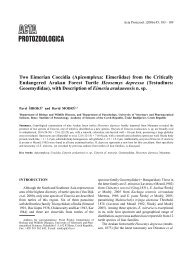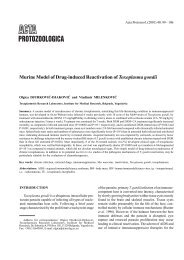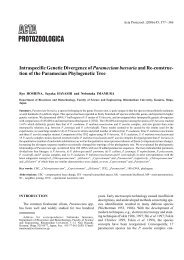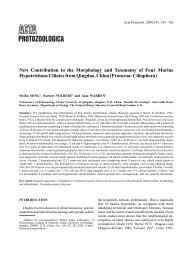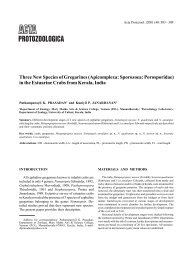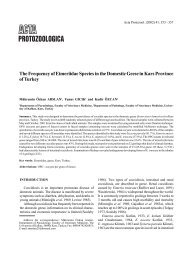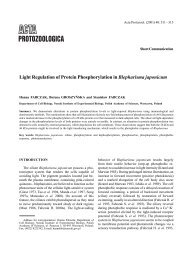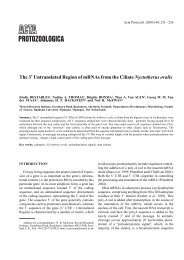Blepharisma intermedium Padmavathi, 1959 (Ciliophora ...
Blepharisma intermedium Padmavathi, 1959 (Ciliophora ...
Blepharisma intermedium Padmavathi, 1959 (Ciliophora ...
You also want an ePaper? Increase the reach of your titles
YUMPU automatically turns print PDFs into web optimized ePapers that Google loves.
68 K. A. S. AL-Rasheid et al.<br />
does not have a filiform macronucleus but about 60 small<br />
irregular, spheroid macronuclei which rules out any close<br />
relationship to the present Arabian organism.<br />
The colour of the ciliate is not an accurate taxonomical<br />
feature, as it is well known that the <strong>Blepharisma</strong><br />
pigment bleaches on exposure to light. The dark pink<br />
colour of the present organism may be explained by the<br />
heavy vegetation shading the saline ponds where it was<br />
found.<br />
In spite the fact that the somatic pairs of kinetosomes<br />
are both ciliated, an unusual feature, we conclude that<br />
the present organism with its filiform macronucleus is<br />
an Arabian strain of the freshwater <strong>Blepharisma</strong><br />
<strong>intermedium</strong> <strong>Padmavathi</strong> (<strong>1959</strong>).<br />
Acknowledgments. We wish to thank Dr. Irwin R. Isquith, School of<br />
Natural Sciences, Farleigh Dickinson University (USA) for his<br />
comments on the taxonomy of the organism.<br />
REFERENCES<br />
Figs. 18-19. Light micrographs of <strong>Blepharisma</strong> <strong>intermedium</strong> after<br />
protargol impregnation. Early (18) and late (19) postdividers.<br />
Cytostome positions are marked by asterisks. Ma - macronucleus,<br />
Mi - micronucleus. Scale bars - 25 µm<br />
kineties reported originally by <strong>Padmavathi</strong> (<strong>1959</strong>) for<br />
B. <strong>intermedium</strong>. In revisions of the genus <strong>Blepharisma</strong><br />
(Bhandary 1962; Hirshfield et al. 1965, 1973), the<br />
number of somatic kineties in B. <strong>intermedium</strong> is not<br />
mentioned. An unusual low number of 25-35 kineties<br />
was also found by Sawyer (1977) in B. japonicum<br />
Suzuki, so this feature may be unimportant (see Table 2).<br />
A striking feature of the Arabian ciliate is, however,<br />
that both kinetosomes of the somatic pairs are ciliated.<br />
This is an unusual feature in <strong>Blepharisma</strong> where most<br />
descriptions on the different species state that only one<br />
kinetosome of the somatic pairs is ciliated. To the best of<br />
our knowledge, the only other blepharisma reported to<br />
have both kinetosomes of somatic pairs ciliated, is<br />
B. parasalinarium (Dragesco 1996). This organism<br />
Aescht E., Foissner W. (1998) Divisional morphogenesis in<br />
<strong>Blepharisma</strong> americanum, B. undulans, and B. hyalinum (<strong>Ciliophora</strong>:<br />
Heterotrichida). Acta Protozool. 37: 71-92<br />
AL-Rasheid K. A. S. (1997) Records of free-living ciliates in Saudi<br />
Arabia. II. Freshwater benthic ciliates of Al-Hassa Oasis, Eastern<br />
Region. Arab Gulf J. Scient. Res. 15: 187-205<br />
AL-Rasheid K. A. S. (1999) Records of marine interstitial Heterotrichida<br />
(Ciliata) from the Saudi Arabian Jubail Marine Wildlife Sanctuary<br />
in the Arabian Gulf. Arab Gulf J. Scient. Res. 17: 127-141<br />
Bhandary A. V. (1962) Taxonomy of the genus <strong>Blepharisma</strong> with<br />
special reference to <strong>Blepharisma</strong> undulans. J. Protozool. 9: 435-<br />
442<br />
Borror A. C. (1963) Morphology and ecology of the benthic ciliated<br />
protozoa of Alligator Harbor. Arch. Protistenkd. 106: 465-534<br />
Dragesco J. (1970) Ciliés libres de Cameroun. Ann Fac Sci Yaoundé<br />
(Numéro hors-série)<br />
Dragesco J. (1996) Infraciliature et morphométire de cinq espèces de<br />
ciliés mésopsammiques méditerranéens. Cah. Biol. Mar. 37: 261-<br />
293<br />
Dragesco J., Dragesco-Kernéis A. (1986) Ciliés libres de l’ Afrique<br />
intertropicale. Fauna Tropicale 26: 1-559<br />
Dragesco J., Dragesco-Kernéis A. (1991) Free-living ciliates from the<br />
coastal area of Lake Tanganyika (Africa). Europ. J. Protistol. 26:<br />
216-235<br />
Foissner W. (1989) Morphologie und Infraciliature einiger neuer und<br />
wenig bekannter terrestrischer und limnischer Ciliaten (Protozoa,<br />
<strong>Ciliophora</strong>). Sber. Akad. Wiss. Wien. 196: 173-247<br />
Foissner W. (1991) Basic light and scanning electron microscopic<br />
methods for taxonomic studies of ciliated protozoa. Europ.<br />
J. Protistol. 27: 313-330<br />
Foissner W., O’Donoghue P. J. (1990) Morphology and infraciliature<br />
of some freshwater ciliates (Protozoa: <strong>Ciliophora</strong>) from western<br />
and south Australia. Invertebr. Taxon. 3: 661-696<br />
Hirshfield H. I., Isquith I. R., Bhandary A. V. (1965) A proposed<br />
organization of the genus <strong>Blepharisma</strong> Perty and description of<br />
four new species. J. Protozool. 12: 136-144<br />
Hirshfield H. I., Isquith I. R., DiLorenzo A. C. (1973) Classification,<br />
distribution and evolution. In: <strong>Blepharisma</strong>. The Biology of a<br />
Light Sensitive Protozoan, (Ed. A. C. Giese). Stanford University<br />
Press, Stanford, California 304-332



